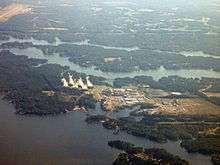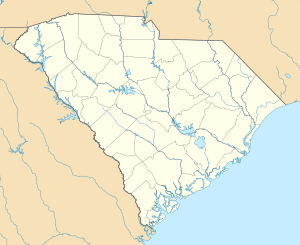Catawba Nuclear Station
| Catawba Nuclear Station | |
|---|---|
 | |
 Location of Catawba Nuclear Station in South Carolina | |
| Country | United States |
| Location | York, South Carolina |
| Coordinates | 35°3.1′N 81°4.2′W / 35.0517°N 81.0700°WCoordinates: 35°3.1′N 81°4.2′W / 35.0517°N 81.0700°W |
| Status | Operational |
| Commission date |
Unit 1: June 29, 1985 Unit 2: August 19, 1986 |
| Construction cost | $6.594 billion (in 2007 USD) |
| Operator(s) | Duke Power |
| Nuclear power station | |
| Reactor type | pressurized water reactor |
| Reactor supplier | Westinghouse |
| Power generation | |
| Units operational | 2 x 1129 MW |
| Capacity factor | 93.1% |
| Average generation | 18,418 GWh |
|
Website www.duke-energy.com/.../catawba.asp | |
The Catawba Nuclear Station is a nuclear power plant located on a 391-acre (158 ha) peninsula, called "Concord Peninsula", that reaches out into Lake Wylie, in York, South Carolina. Catawba utilizes a pair of Westinghouse four-loop pressurized water reactors.[1]
As a part of the Megatons to Megawatts Program Catawba was one of the plants that received and tested 4 fuel assemblies containing MOX fuel with the plutonium supplied from old weapons programs.[2] Because concerns of nuclear proliferation are greater with fuel containing plutonium, special precautions and added security were used around the new fuel. The 4 test assemblies did not perform as expected and at present those plans are shelved.[3]
Ownership
- Unit 1:
- Operator : Duke Power
- Owners: North Carolina Electric Member Corporation (~62%), Duke Energy Corporation (~38%)[4]
- Unit 2:
- Operator: Duke Power
- Owners: North Carolina Municipal Power Agency (75%), Piedmont Municipal Power Agency (25%)
Surrounding population
The Nuclear Regulatory Commission defines two emergency planning zones around nuclear power plants: a plume exposure pathway zone with a radius of 10 miles (16 km), concerned primarily with exposure to, and inhalation of, airborne radioactive contamination, and an ingestion pathway zone of about 50 miles (80 km), concerned primarily with ingestion of food and liquid contaminated by radioactivity.[5]
The 2010 U.S. population within 10 miles (16 km) of Catawba was 213,407, an increase of 53.3 percent in a decade, according to an analysis of U.S. Census data for msnbc.com. The 2010 U.S. population within 50 miles (80 km) was 2,559,394, an increase of 25.0 percent since 2000. Cities within 50 miles include Charlotte NC ( 17 miles to city center).[6]
Seismic risk
The Nuclear Regulatory Commission's estimate of the risk each year of an earthquake intense enough to cause core damage to the reactor at Catawba was 1 in 27,027, according to an NRC study published in August 2010.[7][8]
See also
References
- ↑ "Catawba Nuclear Station". South Carolina Nuclear Profile. U.S. Energy Information Administration. Retrieved 8 April 2011.
- ↑ "Military Warheads as a Source of Nuclear Fuel". World Nuclear Association. Retrieved 8 April 2011.
- ↑ Pavey, Rob (17 November 2009). "Duke Energy won't do more MOX tests". The Augusta Chronicle. Retrieved 11 April 2011.
- ↑ "Duke Energy Carolinas and NCEMC Agree to Purchase Additional Ownership Interest in Catawba Nuclear Station unit 1". North Carolina’s Electric Cooperatives. Retrieved 8 April 2011.
- ↑ "Archived copy". Archived from the original on 2006-10-02. Retrieved 2012-08-17.
- ↑ Bill Dedman, Nuclear neighbors: Population rises near US reactors, msnbc.com, April 14, 2011 http://www.msnbc.msn.com/id/42555888/ns/us_news-life/ Accessed May 1, 2011.
- ↑ Bill Dedman, "What are the odds? US nuke plants ranked by quake risk," msnbc.com, March 17, 2011 http://www.msnbc.msn.com/id/42103936/ Accessed April 19, 2011.
- ↑ http://msnbcmedia.msn.com/i/msnbc/Sections/NEWS/quake%20nrc%20risk%20estimates.pdf
External links
- "Catawba 1 Pressurized Water Reactor". Operating Nuclear Power Reactors. U.S. Nuclear Regulatory Commission (NRC). February 14, 2008. Retrieved 2008-11-15.
- "Catawba 2 Pressurized Water Reactor". Operating Nuclear Power Reactors. NRC. February 14, 2008. Retrieved 2008-11-15.